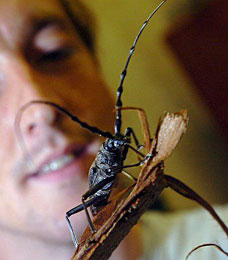Rare Giant Beetle Scares Workers But Survives
Rare giant beetle scares workers but survives
From: http://www.dailymail.co.uk/pages/live/articles/news/news.html?in_article_id=392772&in_page_id=1770
15:45pm 27th June 2006
A giant beetle unseen in the UK for 300 years and rare anywhere in the world has been discovered living in Llanelli.
Startled workers at a furniture restorer almost smashed the bug to bits with a hammer in their fear before cooler heads prevailed.
Others believed the 2.6 inches long bug, with two antennae up to 4 inches long, was a child's plastic toy brought in as a joke.
In fact it turned out to be an extremely rare Capricorn beetle looking like a frightening throwback to the age of dinosaurs.
Staff at Foothold Group, in Llanelli, south Wales, use recycled wood to make new furniture, and saw the big bug crawl out of a pile of English oak.
When it proved to be home to a beetle grub and a second, dead, beetle, they were more fearful than pleased with their rare find.
"I was gobsmacked because it was bloody huge for a beetle," said Tony Giles, the workshop manager.
"There were a few suggestions to start with between getting a 2lb hammer or just throwing it out of the window. Cooler heads prevailed."
Local entomologist Ian Morgan was called and he immediately recognised the importance of the find.
He told the Western Mail in Cardiff: "This type of long-horn beetle was supposed to be have been extinct in the UK since 1700.
"This is the first time in centuries that it has been seen here in Wales.
"It is a male and he was found in timber labelled English oakwood, so it makes you question whether this massive beast is alive in England too.
"I realised he was something special as soon as I saw it. It is very rare and is the largest long-horned beetle in Europe.
"There is also a possibility that he might have been imported from central Europe.
"The beetle depends on very large oaks for its grubs to feed on over a long period.
"It is illegal to kill it anywhere."
The beetle, which has a short life-span, is expected to survive for only another two weeks.
After its demise its body will be donated to the National Museum of Wales, where it will be exhibited.



